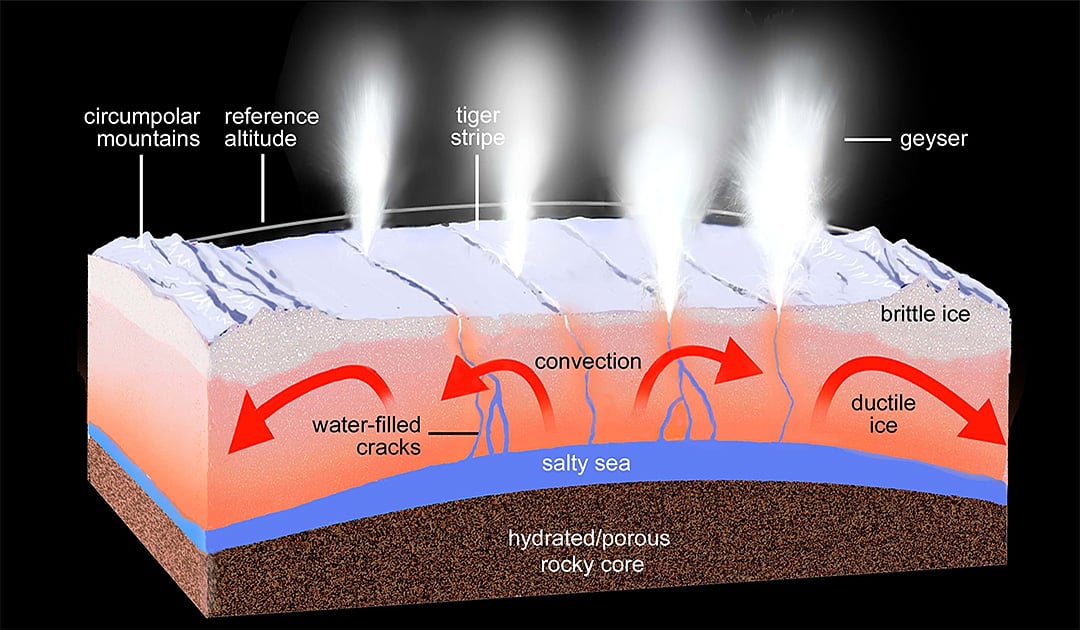
The ocean of Saturn’s moon Enceladus may be more active than scientists previously believed. Enceladus is one of 82 moons of Saturn discovered to date. This tiny moon, just 505 kilometers across, is one of the most promising potential sites for life in the solar system. New theories based on the shape of the ice shell suggest that the ocean of the icy moon, 20 kilometers below the surface, may have currents similar to those on Earth.

Enceladus has at least five different terrain types on its surface. Craters crisscross the landscape and reach sizes of no more than 35 km in diameter. Other regions are smooth and free of crater impacts, indicating a more recent surface. Planes, cracks and fractures in the crust also draw the surface.
Scientists have been keeping a close eye on Saturn’s moon Enceladus since 2014, when the Cassini spacecraft caught dozens of geysers gushing through cracks in the ice shell. This new theory challenges earlier thinking that Enceladus’ global ocean is largely homogeneous.

The ocean on Enceladus is almost completely different from that on Earth. The Earth’s oceans are relatively shallow, averaging 3.6 km in depth, and cover three-quarters of the Earth’s surface. At the top, the water is warmed by the sun’s rays and at the depths, near the bottom, it is colder. In addition, the oceans have currents that are influenced by the wind. Enceladus appears to have a world-spanning and completely “subsurface” ocean at least 30 km deep, cooled at the top near the ice shell and warmed at the bottom by the heat of the lunar core. This is reported by the “California Institute of Technology” on its website.
Despite the differences, Caltech doctoral student Ana Lobo thinks the oceans on Enceladus have currents similar to those on Earth. The work is based on measurements from Cassini, as well as research by Andrew Thompson, professor of environmental science and engineering. Thompson has studied how ice and water interact to drive ocean mixing in Antarctica.
The oceans of Enceladus and Earth have one important feature in common: they are salty. And as the results, published March 25, 2021 in Nature Geoscience, show, variations in salinity could serve as drivers of ocean circulation on Enceladus, much like in Earth’s Southern Ocean surrounding Antarctica.

Discovery and naming
Enceladus was discovered on August 28, 1789 by the German-British astronomer Wilhelm Herschel. Enceladus was at that time the sixth moon of Saturn discovered and the twelfth moon discovered in the solar system.
Because of its orbit, which at that time was the second closest to Saturn, it was designated by the International Astronomical Union (IAU) with the Roman number “II” as the second innermost of the seven large moons of Saturn known up to that time.
The name “Enceladus” as well as names for seven other moons of Saturn were proposed by Wilhelm Herschel’s son, the astronomer John Herschel, in the 1847 publication Results of Astronomical Observations made at the Cape of Good Hope . Enceladus is Saturn’s sixth largest moon and ranks 17th among all planetary moons in the solar system. It is exceptionally bright because it is covered extensively with pure water ice, which reflects 99% of the incident sunlight.
Enceladus is the second moon of Saturn, besides Titan, that has an atmosphere.
Heiner Kubny, PolarJournal
More on the subject:





